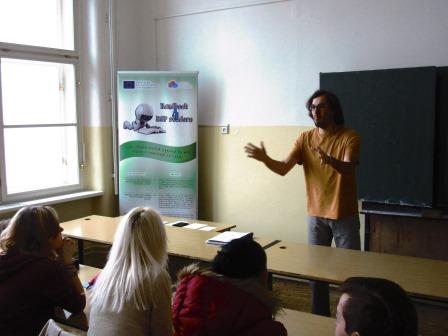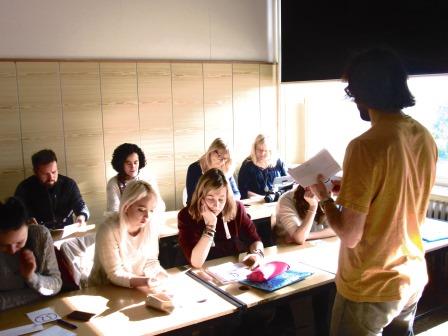
Dissemination
Our visit started with exchanging ideas about different educational systems – Czech, Swedish, Croatian and Spanish, while having a coffee. Of course, it is much more beneficial to learn about other educational system from interaction than from reading from Wikipedia.
First lesson we attended was history of art, where the teacher Miss Martina Strnadova presented us the gothic movement in art (for 4A1 seniors). The lesson was highly interactive, funny and educational. It was history of art in English language, particularly prepared for the visit of international teachers. However, students’ level of English was very high, so students were able to follow and participate in the lesson. We learned about gothic movement in general. Since Miss Strnadova used visual stimuli, we saw the most representative examples of gothic buildings in Czech Republic and in the world. In the end we had a quiz to evaluate how much we remembered from the lesson.
After the history of art, we had school tour guided by two students. We could see how the interior of the school is filled with examples of project – based learning. School walls are filled with works of art made by students. There are sculptures, pictures, photos, poems – the quality of being creative is very important in this high school.
Next lesson was English lesson held by English teacher Mr Jan Pytel. It was part of Erasmus+ project “Handbook for RSP Readers”, which product is creating a handbook with different stories. Our lesson began with self-reflection; we had to think about the relationships in our lives. Furthermore, we had to create names for different groups of people around us, and describe the each category. I have to point out that those were very engaging activities, because often you don’t even think about those questions. We continued to discuss about the importance of meeting new people, and answered on two main questions related to meeting new people: where and how. Teacher paid attention that each student has to participate in answering the questions. Finally, students had to write a short dialogue between two people who meet for the first time.
We reflected some other issues related to the topic: for example, is it possible to recognise people to whom you can trust? Or what does it mean to be useful?
And then we came to storytelling. Teacher gave us short story titled A Readhead, written by Russian author Daniil Kharms in 1937. It was very simple piece of text, but the teacher guided us how to read between the lines, so that we can notice something which is not so obvious at the first glance. Due to teacher’s help, we perceived the story from many different angles. It is actually the art of reading; the whole world can open when you learn how to read.
Based on the same story, we made a logo of the character from the story, which was interesting activity because it challenged multiple intelligence skills. We continued to talk about ideas and feelings stimulated by this story: what is the relationship between writer and the character? Is it possible to live a life without friends? What does it mean to waste life?
It was interesting how many questions you can ask on a basis of such a simple piece of work. It is the magic of reading.
Last lesson we had was of different kind – it was practical art lesson, held by Miss Petra Viltova. The concept was the following: students firstly make a sketch of some logo (famous fashion brand, etc.), and later they put it in 3D. It was interesting to see how they are producing something real in the end of the process.
It was one more successful visit to cooperative and engaging school Nahorni. Thank you for being our hosts, and looking forward to meeting you again.
Katarina (Croatia)
Fernando, Ana and Matilde (Spain)
Lina and Ase (Sweden)



Contact
X gimnazija ''Ivan Supek''
Ul. Vjekoslava Klaića 7
10000
Zagreb
E-mail: partners@handbook4rspreaders.org











